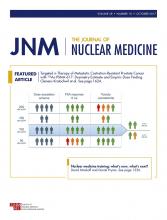REPLY: I would like to respond to the wonderful commentary from Dr. Andrei Iagaru regarding a paper my colleagues and I recently published in The Journal of Nuclear Medicine (1). The heterodimer comprises two monomers that target two distinct types of receptors and are covalently linked. Consequently, one major advantage of the heterodimer over the corresponding monomers is the multivalency effect, resulting in improved binding affinity and an increased number of effective receptors (2). However, after covalent conjugation, the heterodimer is a new compound, which would show different in vivo pharmacokinetics from the monomers. Thus, it is not surprising that bombesin–arginine-glycine-aspartate (RGD) showed different distribution patterns within normal organs and tissues from either RGD or bombesin alone. If we mix RGD and bombesin, the similarity of the background would be improved, but that is not the purpose of this study.
I and my coauthors agree with Dr. Iagaru that it is challenging to reflect distinct pathways through imaging with heterodimers since the imaging intensity relates to both tumor angiogenesis by the RGD moiety and gastrin-releasing peptide receptor level by the bombesin moiety. However, the major goal of the study was to provide a better detection rate for primary lesions and metastases of prostate cancer instead of knowledge of tumor angiogenesis and gastrin-releasing peptide receptor level. From this point of view, the study was successful because bombesin-RGD PET is better than bombesin PET in lesion detection (1). As pointed out in Dr. Iagaru’s commentary, the imaging results from bombesin-RGD cannot be used to guide therapy using either RGD or bombesin directly. Because of the high tumor uptake and retention of bombesin-RGD, we are planning to label the heterodimer with β- or α-emitting radioisotopes for endoradiotherapy, which manifests the theranostic value of the heterodimer.
Most clinical trials are a natural consequence of promising preclinical investigations with the purpose of better serving patient management, and bombesin-RGD is not an exception. Both preclinical studies and the pilot clinical study demonstrated the potential of this heterodimer as a PET imaging probe. We are also aware that only a few of the plethora of candidate pharmaceuticals will eventually be approved in clinical trials. Sufficient caution is needed, but exploration is also needed to expand the arsenal for the diagnosis and treatment of malignant diseases. As has been said, it doesn’t matter whether a cat is white or black, as long as it catches mice.
Footnotes
Published online Aug. 3, 2017.
- © 2017 by the Society of Nuclear Medicine and Molecular Imaging.







